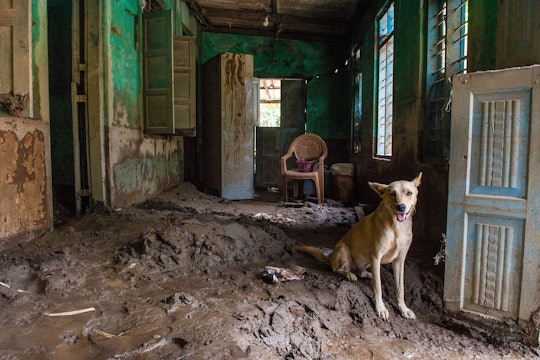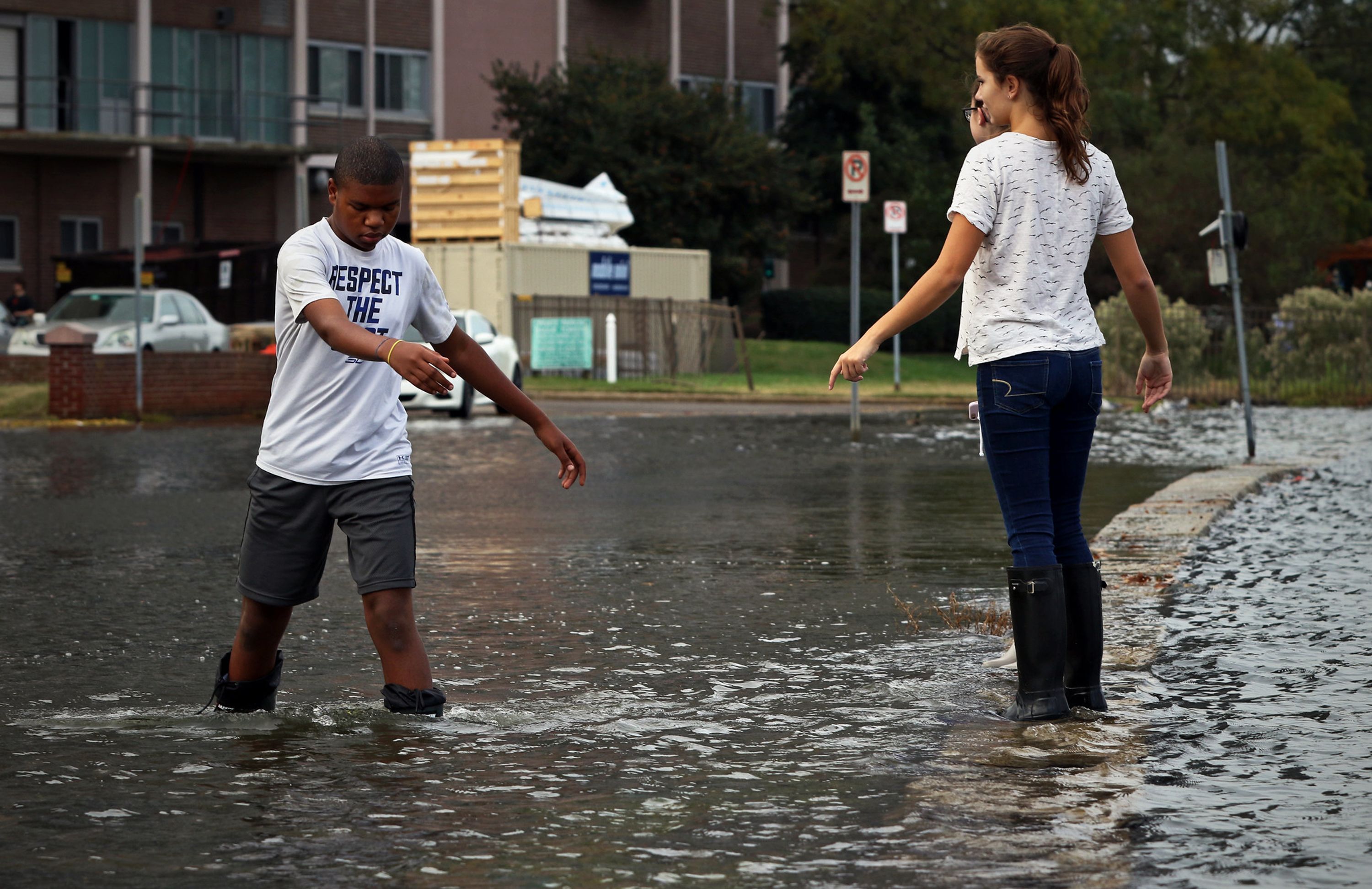
SJ Sreerag via Wikimedia

A version of this story originally appeared on Science at Pioneer Works
The wealthy are hoarding livable homes as climate change makes land uninhabitable
How climate change floods, boils, and leaves gentrification in its wake
To the science-minded person, it can be comforting to divide humanity into sane, rational climate change believers (like themselves) and dangerously deluded climate change deniers. Unfortunately, as psychologists who study climate anxiety are wont to point out, in practice most people are somewhere in between — trying to ignore the looming new reality just enough to continue on with their lives and business. That kind of short-term thinking is on full display here in Miami Beach, where spring breakers frolic despite coronavirus, and billions of dollars are sunk annually into developing new hotels that will be uninhabitable, a foot underwater, in our lifetimes. To live in Miami with the realities of climate change in mind, is to see everything through disaster goggles — the myopic thinking of the market at its most disastrous. You walk through America’s great party city as the ultimate vibe-killer — the person who spoils the party by asking when everyone is thinking of leaving.
Xavier Cortada has had a bad case of this for a while now. The Miami artist visited Antarctica in 2006, and has since felt like a prophet of doom. “I got a perspective on what’s really happening to Antarctica, and what was going to happen to Miami,” the artist recalls. “They gave me pieces of the ice that threatened to drown my city.” He pictured the Catholic church and the schools he attended, everything that he loved, a sunken civilization. This may sound like hyperbole, but according to research projections by Climate Central, if we don’t find a way to stem the tides, these streets will be “waterways” by 2100 — waterways from the glamorous downtown Brickell area to Little Havana, roofs jutting out of the ocean.
Always adept at hedging, the market is starting to anticipate this slow retreat from the coast. Real estate developers who once priced people out of beach neighborhoods are setting their sights on the places they displaced them to — and are now starting to develop elevated neighborhoods like Little Haiti that, until recently, weren’t desirable to the beach-bound jetsetter. Local researchers have coined a term for this incipient trend: “climate gentrification.” It demarcates a new process of reappraising where it will be safe to live in the future. It foreshadows a struggle where climate refugees are an internal issue as much as an international one — where rich people take for the hills, pushing poor people out to persist on the margins of disaster. If you look closely enough, you’ll see it happening all across America.
Beachfront Insurance
Miami is at the vanguard of this development because of its precarious setting and its reputation as a developer’s paradise. The city is built on a bed of porous, soft, sandy, flood-prone limestone (appropriately called Miami limestone) most of it only a few feet above sea level. Water easily seeps through the holes in the limestone, like a “reverse percolation.” This combination of spongy ground and high rises has made it the “most vulnerable coastal city worldwide,” which is more a measurement of the amount of real estate money on the line than the human toll of rising seas (which will likely be felt much more strongly in poor coastal cities in South East Asia). By 2040, more than $3 billion dollars of property here could be lost to flooding.
City officials are torn between their long-term responsibility for residents’ safety and their economic dependence on booming waterfront real estate. These competing interests have led them to offer optimistic forecasts about the city’s fate, despite climate projections that suggest a sea level increase of 3 feet by 2060, and the regular occurrence of hurricanes previously considered “once-in-a-century.” While climate experts suggest encouraging people to evacuate future flood zones, local officials prefer not to scare off homebuyers and investors. Their suggested strategies (derided by a climate expert as “just enough to reassure developers that Miami’s safe enough to build in the near-term”) include building more houses on stilts, raising the ground under new developments, and building much more densely in the few elevated neighborhoods in Miami.
These piecemeal strategies are developer-friendly and do not address what will happen to existing housing — or what this will mean for residents who can’t afford to build a new house (or who won’t be able to afford flood insurance when it gets prohibitively expensive). More than half of Miami’s affordable housing stock is currently situated below the city’s average elevation of seven feet above sea level. Already, cheaper waterfront units are flooding regularly. Residents of these houses resort to stacking bricks around their homes in hopes of preventing the water from damaging their homes. As newer, wealthier residents raise housing prices, Miamians living in lower elevations have struggled to find affordable units further inland.
Lower income communities in elevated neighborhoods are feeling the other side of this squeeze. Little Haiti sits on “the ridge,” an area in Miami that has above average elevation, about 11 feet above sea level. This increasingly-popular enclave is dotted with bright murals celebrating the longtime Haitian residents and the life they created in this neighborhood over the years. Caribbean immigrants settled here in the mid-20th century in response to red-lining and segregation, and are now finding their homes and businesses displaced by a rush of new commercial and housing developments.
Developers in this neighborhood are doing their best to push low income renters out, with a tried-and-true combination of neglect and incentives. New investors are swooping in. “Developers are not stupid, they know that climate change is real and they want to protect their future investments,” says Adrian Madriz, executive director at Struggle for Miami’s Affordable and Sustainable Housing,. ”[A landowner may] actually sit on the property if they have no intention of developing… So there’s a lot of slum and blight in the neighborhood.”
To rich people, this kind of displacement may not seem so tragic, but to communities in Miami once known as exiles it comes as another displacement. Xavier Cortada worries that Miami will soon be whitewashed of its unique Caribbean culture. “There’s this reality of communal living at the core... and that that group of people can disappear. And no one will ever take note that it happened,” he says. “So the very fabric that has made Miami all these years, is about to become something new, like a Las-Vegas-meets-Monte-Carlo type thing.”
Cortada does what he can to raise awareness in his community. In 2018, he created the “Underwater HOA,” a participatory art project that encouraged Miami homeowners to place a yard sign that showed how many feet the Atlantic Ocean must rise before their property is underwater. For some homeowners it was less than 10 feet. Sea levels around Miami are expected to rise an average five to six feet by 2100 city-wide, and up to 230 feet if all glaciers and ice caps on Earth melted. Cortada says his efforts have been a way for him to come to terms with the reality of how his city, alongside much of South Florida, will probably be wiped off a map by the end of the century. Thinking and creating art around these scenarios has connected him to the pain his own family and community felt when they were exiled from their home, only a couple hundred miles from here, in the Caribbean, decades ago.
Disaster capitalism
More than just the effects of climate change, low income communities in the coastal United States have to worry about local officials and real estate interests seizing on these emergencies as opportunities to displace their families. These efforts are occurring in a particularly blatant way one thousand miles up the coast from Miami, in Norfolk, VA, a town known as the Mermaid City, an apt name for an increasingly amphibious place. The sea level near Norfolk is expected to rise more than 4 feet by the end of this century, a report from the Union of Concerned Scientists predicts, slowly escalating a near-unlivable situation.
Local resident Lavonne Pledger, a personal trainer, entrepreneur and community activist, is already a veteran of the floods. “I lost a car out there,” he explains. “If you park overnight and it rains overnight...you wake up and your car’s full of water. People are constantly losing possessions and vehicles.” For the last 10 years, he has lived in one of the designated public housing areas in Saint Paul’s Quadrant, which comprises three extremely flood prone neighborhoods individually called Tidewater Gardens, Calvert Square, and Young Terrace, with more than 1,600 public housing units that are home to mainly working class Black residents. Many of the houses are old and in disrepair. Pledger doesn’t always have hot water in the mornings, things break, sinks clog; black mold dots the bathroom walls and ceilings. “The city has created this problem by putting Black and Brown communities in an area where they shouldn’t be — and that’s right on top of a creek,” he says.

Children in Norfolk, Virginia, record the "king tide" after a flood in 2019
Courtesy of Aileen Devlin, Virginia Sea Grant
Much of Norfolk, indeed much of the Eastern Seaboard, used to be wetlands — swamps and marshes. Many were drained by hand-dug ditches, as permanent settlements dotted the coastline after colonial settlement. What remains is low-lying land built along creeks and streams that flood regularly and damage property. Norfolk elected officials have responded to the recent flooding by pushing for new developments — and planning to demolish public housing neighborhoods like Young Terrance where Pledger lives with his two teenage children. They promise to “revitalize” the area in hopes of decentralizing poverty and creating “desirable neighborhoods where residents of all income levels, races, ages and cultures can live, learn, work, play and thrive.” Residents like Pledger know exactly what that means.
Displacements like this have been shaking the branches of Pledger’s family tree for decades. His grandmother used to live in East Ghent, a predominantly Black community that sat alongside a whiter, richer neighborhood, known simply as Ghent. Years of neglect and bad policy plagued East Ghent and by the early 1970s, Black residents were pushed out of the neighborhood. The city seized homes through eminent domain, demolished many others, and created what is now another middle class, majority-white neighborhood. His grandmother eventually moved to another home in Norfolk, while other residents left altogether. “That displacement set her and set my family back,” Pledger explains. “Who knows where my life might be? I really do feel as though the environment you’re in dictates the person that you are.” He asks himself that question again and again, especially now that he is being pushed out both by city officials and climate change — two complimentary forces that sometimes feel almost impossible to resist.
Shock Doctrines
New Orleans was a harbinger of all this. Dr. Beverly Wright, the executive director for the Deep South Center for Environmental Justice in Louisiana, witnessed how Hurricane Katrina whitewashed the city. “New Orleans is kind of leading the band in gentrification,” she explains. “We are held up as being this great success story after a severe weather event like Katrina — we are seen as a comeback kid — and that is just so far from the truth.”
A 2015 report by the Urban League of Greater New Orleans titled “State of Black New Orleans: 10 Years Post-Katrina” broke down the dismal recovery of Black communities in the city after the hurricane. It outlined how inequality before the storm made pushing out residents of color possible in the reconstruction that followed. “The incomes of the poor did not afford many citizens the luxury of evacuating, so they remained in peril of a killer storm,” the study outlined. “It was largely African-American, Vietnamese and poor populations who lived in the areas most vulnerable to the collapse of the levees, who were unable to secure transportation for evacuation.” In the 15 years since, the city has become wealthier and whiter.
About 100,000 Black homeowners, small business owners, and other longtime residents have since been permanently displaced, dispersed to other cities across the South including Houston and Dallas. The city sold this as a way of “breaking up concentrated poverty — something that government officials had been trying to achieve for decades,” the report explains. In the aftermath of the storm, officials offered government contracts to large corporations instead of local businesses. Urban planners and developers swarmed in hopes of building a “dream city” for newcomers with disposable income. This process, as a report from the Natural Resources Defense Council puts it, may be seen as a dry run for what is going to happen to poor communities all over America in the age of catastrophic climate change.
Higher Ground
Unfortunately for us, climate change doesn’t only threaten to make our coasts uninhabitable. Extreme droughts and heat waves could force the reorganization of society in the interior of the country too. Farming regions are slated to shrink, with more and more rich soil becoming its lifeless cousin, dirt. Wildfires are expected to rage longer and hotter, leaving our richest ecosystem no time to recover, creating widespread desertification. And then there’s the direct impact of the heat. Where will our most elderly citizens hide from the constant onslaught, as the number of heat deaths increases very year? This, if current trends persist, will depend very much on their income bracket.
Those who can afford it move to places like Flagstaff, in northern Arizona. Settled on the southern tip of the Colorado Plateau, a geologic four-corners that connects Utah, Colorado, New Mexico, and Arizona, Flagstaff enjoys a temperate climate, buffeted by the largest Ponderosa Pine forest in the world. Compare that to Arizona’s sprawling capital, Phoenix, baking in the flats of the Valley of the Sun. You can see the advantage in satellite pictures: Flagstaff sits invitingly in a strip of green while Phoenix is stranded in a beige desert.
In the summer of 2017, Phoenix reached a new temperature record of 119 degrees Fahrenheit. It was so hot that some residents claimed that their mailboxes were melting. Phoenix residents posted photos of themselves cooking food with the heat of the sun and even baking cookies in their cars. This is already one of hottest places in the US, according to an EPA study, and it is only getting hotter. Heat waves killed a record 500 residents in 2020 compared to under 300 deaths in 2019. With one of America’s top retirement capitals becoming increasingly unbearable, more and more rich outsiders are building second homes in Northern Arizona.
Coral Evans, who’s lived in Flagstaff for much of her life, including a four-year tenure as mayor, has witnessed sudden changes in her city over the past few years. The Black, Latin American, and Indigenous families that live in her neighborhood are slowly being priced out. This, she says, is starting to oppress the area’s famous family-friendly, funky, communal vibe. The new residents are known here for their noise complaints, which bring police officers to birthday parties and barbecues. The money migration has rapidly changed the local housing market. Flagstaff now ranks in the top 10 cities for second home ownership. A little over a quarter of mortgages taken out here in 2019 were for second homes.
But the heat waves are hitting Flagstaff too. Evans recalls the bubbling rivers and lakes of her childhood, now slowly drying out. The kind of communal upbringing she enjoyed, eating freshly caught fish with her grandparents from the local lakes, eating fruit from local trees, and exchanging food with her neighbors, no longer feels possible. The trees from her childhood have withered and died, rents and utility bills have gone up, and locals are out barbecuing in usually-frigid December. Like residents in Miami or New Orleans, Evans is seeing her way of life disappearing, amid a wave of hot weather and wealthy newcomers. She worries about her daughter, who is fourth generation, not to mention the fifth and sixth generations that may follow. “I don’t think they’ll experience the same Flagstaff I did.”
Just the Beginning
Climate change, it is often said, is on course to render large swaths of our country — indeed, much of Earth — uninhabitable. In practice, however, our political and business leaders may just redefine what constitutes tolerable living conditions. Early climate change gentrification is a harbinger of a world where only rich people can afford to live in places that are relatively cool, unflooded, beyond the reach of hurricanes, tsunamis, earthquakes, and wildfires.
Will we abandon our coastal cities, or will the urban poor inhabit floating neighborhoods that extend into the ocean, as they already do in places like Bangladesh or the Niger delta? This choice may now seem nightmarish, but it is a logical continuation of our current course.
To avoid that fate, we will need to do a lot more than rebuild our cities to withstand the coming waves of water and heat. The age of catastrophic climate change will be an age of mass displacement unless we create a new social contract — based on a new expanded understanding of human rights and property rights — to prepare us for the squeeze. There are times when the world must be turned on its head in order to be stood on its feet.
